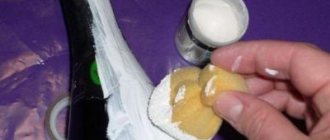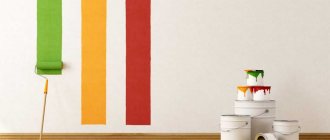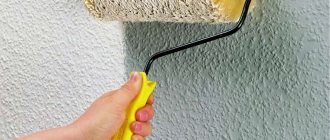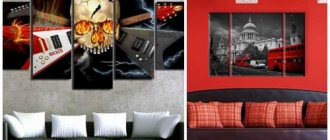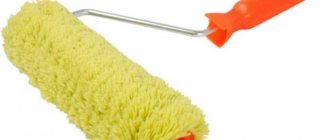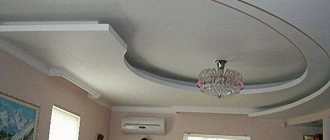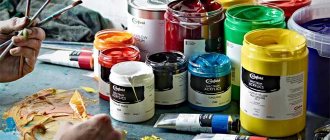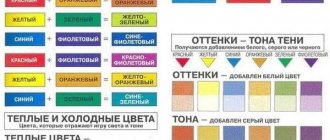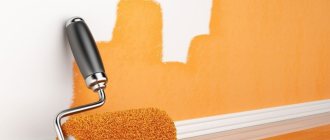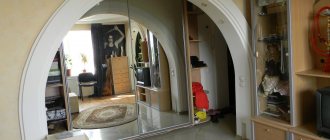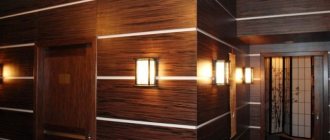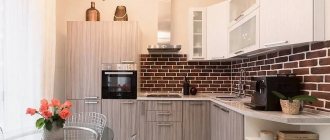Application, features
Glow-in-the-dark paints are used to decorate interiors, building facades, color various products, clothing, souvenirs, furniture elements, cars, bicycles, and advertising banners. With their help, magnificent paintings and wall paintings are created.
Available for various applications:
- interior or façade;
- for wood, glass, metal, plaster;
- translucent, transparent;
- with high or low moisture resistance.
Most compositions are made on an acrylic base with suitable properties. Several primary colors have been created that can be used to create different shades when mixed. When choosing, pay attention to the labeling and operating conditions.
Luminescent and fluorescent paints differ in their reflective properties and are used in different conditions.
Luminescent paints
Paints containing phosphor act on the principle of a light-storage battery. During the day they accumulate light and are then able to glow in complete darkness.
- 30 minutes of charging is enough for 12 hours of glow.
- The light intensity gradually decreases.
- Pure phosphor has a greenish or blue glow; with the addition of dyes, different colors are obtained.
- Service life up to 30 years.
- Refers to expensive materials.
Luminescent paint is almost invisible during the day, so it can be applied to any painting without fear of being damaged. And at night, the usual picture on the wall will glow with any applied color scheme from the selected shades, and present a fantastic show.
Fluorescent paints
These luminous paints do not accumulate sunlight, but brightly reflect ultraviolet rays. Therefore, such paintings are supplemented with UV lamp lighting.
- They have many bright colors and shades;
- The coating fades when exposed to sunlight and is destroyed at high temperatures;
- They belong to the budget price segment.
Universal composition
Manufacturers have created a mixture that glows in the dark and from UV rays. It is a coating of reflective pigments and phosphor. Features bright colors. It is used to create decorative wall panels and in other areas.
Main varieties
There are several types of luminous coloring materials, which distinguish different light-emitting components in the composition:
- Phosphor (luminescent) paint. A universal coating with a fast light-accumulating effect (up to 30 minutes) and a stable glow for more than 10 hours. Compositions based on phosphors are used to paint any surface: from walls in an apartment to body art or elements on a uniform.
- Fluorescent paint. This transparent emulsion is not visible in daylight, but emits brightly in ultraviolet rays. The acrylic base ensures the reliability and durability of the coating, which does not fade over time. Painted surfaces have rich colors: yellow, green, red and purple shades are often used in the design of nightlife establishments.
- Phosphorus paint. With the advent of modern materials it is rarely used. The toxic composition makes it unsuitable for indoor use, so phosphorescent paint should be used with caution and safety precautions must be observed.
- Reflective paint. It is made with the addition of pigment from colored crystals that sparkle when light rays hit them. The color range does not change, which distinguishes such enamels from fluorescent enamels, which reflect rays in a different color spectrum. It is used for the production of special clothing, marking of hazardous areas in production, markings on roads.
Fluorescent paint to highlight hazardous areas.
Painting with fluorescent paints
Often luminous paintings are created based on an existing wall painting, resulting in an unexpected fairy-tale effect. But sometimes designers apply a design with fluorescent paints on a plain surface. During the day it is an ordinary wall, but at night a fantastic picture appears on it.
This finishing material is applied in various ways:
- brush;
- roller;
- aerosol.
By purchasing fluorescent (neon) pigment and mixing it with clear varnish, you can save money.
Application rules
The technology for using fluorescent paints depends on the form of release. Aerosol types are easy to use. The designer just needs to shake the can and apply the composition to the surface. Stencils are great for creating beautiful, professional images.
Glowing design Source tempusliberum.ru
Small areas or paintings with a lot of detail are easier to paint with a brush. First mark the contours with a pencil. Small fragments are applied with narrow, thin tools; for large fragments, a wide shaving brush is used. Decorative elements are painted in one direction, then given time to dry and re-painted in the opposite direction.
Fluorescent painting on the wall Source myhome.ru
Wooden decor Source omart.com.ua
Paint is applied to large areas using rollers. The raw material is poured into a cuvette in which the instrument is dipped. Gently pass over the surface, trying to apply even pressure. If you need to quickly paint areas, designers recommend taking a spray gun.
The sponge will provide a gradient or unusual texture. The image changes depending on the pressure on the foam. The effect of Venetian plaster will be created by twisting dry fabric. The material is fixed on a roller, dipped into a fluorescent emulsion and slowly passed over the surface. The type of pattern depends on the hardness and stiffness of the rag. The decor is secured on top with varnish.
Luminous painting Source ultraviolet.guru
Facade with reflective design Source graffitirussia.ru
Applying neon paint to a surface: effect in the dark
This material is based on an acrylic binder. Therefore, water is suitable as a diluent, and a special distillate is suitable for spray guns. When applied, the composition dries quickly, resulting in a durable film.
Application Tips:
- you need to work in a warm, well-ventilated area;
- use rubber gloves, safety glasses, respirator;
- for adhesion, the paint is applied to a clean, dry surface, which should preferably be treated with a primer made of acrylic copolymers;
- to immediately monitor the result, the room should be dark and the UV light should be turned on;
- The treated surface should be dried with good ventilation, but without drafts.
Question answer
Sergey, good afternoon. Wonderful work, I got a lot of pleasure from the highly professional approach and creative thought!))) Cool site! You are very attentive and open.)) Well, since this is the case, I would like to take advantage of your wonderful experience and generous attention. Please take a look at these works and how much you would value them at, roughly at a glance. I would be grateful for criticism and advice. The first two photos are oil. The third is half of the drawing of the future work on the walls converging at an angle. The size of the half is 1x2 meters. I won’t insert the second half as the fourth file)). You can look in more detail on the contact page - vk.com/aleks.sander +(vk.com/skaz_o_remonte). It would be great to learn from you. By the way, are you putting together a team? Most likely, I think you are a loner..)) Thanks in advance for your answer. Read the answer
Hello Sergey!
I admire your works! Can I ask a question or get some advice? I moved into a room that had already been renovated, and there was expensive wallpaper on the walls, but with a light beige-yellowish color that irritated me. I came up with the idea of painting the wallpaper in the form of stacked even, more or less smooth stones, but so that the stones would not have a street look, like, for example, the stones in the painting in the hallway. I read all your answers to previous questions. But something remains unclear. You said that there is an option of white acrylic or water-based paint + colors for dilution, but you write that this is a confusing option and you don’t use it.. Then it turns out that you advise taking ready-made colors? And what is better for painting stones? I would like to get a medium beige color and do I need to register light and shadow if the entire wall seems to be laid with stone, and this is not part of the landscape. But also so that the stones do not look like bricks of the same color. It seems to me that we need to make an imitation of a stone wall, as you did in the kitchen painting, where it looks like pink marble. I’ve never done this, but I think I can do it from a photo. Thanks in advance! Read the answer
Hello, I want to express my admiration for you!!! You have a gift from the Lord!!! 10 years ago I graduated from art school and completely stopped drawing, you inspired me!!! I want to paint the doors in the pantry made of fiberboard and painted Also Saldepovskaya oil paint, tell me what to prime and what paints are better to choose? Thanks in advance. Ekaterina.
Read the answer
Features of fluorescent paint and its scope of application
You can often see decorations with a glow effect in the design of rooms. Beautiful and bright drawings on the walls or ceiling attract attention. This is explained by the fact that fluorescent paint is used for coloring.
The composition of the fluorescent dye is enriched with luminous ingredients, which provide its properties. On sale you can find both visible fluorescent pigments and hidden, that is, paints invisible during the day.
Features of luminous palettes
Fluorescent paint acquires its glowing properties from the addition of a special pigment, which appears in ultraviolet light. This pigment is a polymer that is coated with a special compound - a fluorophore. It is non-toxic, so such paints can be safely used for interior decoration.
You should know that fluorescent and luminescent paint are different things. Fluorescent pigments only reflect rays, while luminescent pigments accumulate energy and then release it in the dark.
Pigments create a more colorful effect in the dark, so their area of application is usually aimed at night decor. In the dark, the composition glows several times stronger than during the day.
Therefore, to enhance the effect during the daytime, visible fluorescent dyes are used. Wall paint can be different: pink, blue, gold, etc.
Invisible paint is completely invisible during the day; it begins to fluoresce only in the dark.
Invisible fluorescent paints from KUDO and BOSNY are of high quality and therefore in demand.
In the video: luminescent and luminescent-fluorescent paint.
Application area
Fluorescent paint is used for designer decoration of both interior spaces and facades. With its help, paintings, three-dimensional compositions and other design things are created that can be done without involving craftsmen.
If you have even the slightest ability for creativity, then you can do the finishing yourself. There are also fluorescent watercolors; it is easiest to paint with paints in spray cans. Pigments in KUDO or BOSNY cans are very popular.
Very often, painting is used to decorate public spaces: restaurants, clubs and other entertainment venues. It is in such establishments that fluorescent colors create a luminous atmosphere. Red fluorescent paints look especially original.
Acrylic luminous pigments are used for Body Art. The paint used for the body is absolutely safe, as it is made on a water-dispersion basis.
Types of luminous paints
Consumers often ask: what is luminous paint and what types does it come in? Fluorescent paint is available in several types, depending on the base used for its manufacture:
- Fluorescent enamel on acrylic base. Used to implement design solutions indoors. Pigment particles are added to it, which glow when exposed to sunlight. They have different colors. You can achieve any other shade by mixing the colors yourself. Acrylic pigments are very good for painting materials such as drywall, wood, and plaster. Painting metal or plastic is not recommended.
- Acrylic facade pigments. They are characterized by a high degree of resistance to mechanical and atmospheric influences. They do not wear out over time and have a water-repellent effect. That is why such decorative coating can be washed without fear of using detergents and cleaning products. But at the same time, the paint allows air to pass through, the walls can breathe. It covers concrete, stone, and brick walls. Can also be used for painting metal, plastic and wooden surfaces. This type of material can be used outside and in rooms with high humidity. For example, to create a glowing effect in the bathroom.
- Alkyd aerosol ultraviolet paint. It is universal. The advantages of such enamels are their resistance to various factors and quick drying. Experts recommend purchasing paints from proven manufacturers, such as KUDO or BOSNY. It is the pigments of these companies that provide high quality fluorescent effects. In addition, they can be used to paint wood and plaster, as well as plastic and glass.
We recommend: Which nitro enamel to choose for metal surfaces
Application instructions
The method of applying fluorescent watercolor depends on the condition of the surface. It can be embossed or smooth, rough or smooth.
Tools that can be used: paint brush or paint roller, foam swabs or paint sprayers. To make the painting process easier, you can purchase foam holders.
Watercolor can be splashed on the wall, and small objects can be dipped into the paint.
You can also paint the wall with fluorescent paints from a spray can. These are produced by KUDO or BOSNY.
Direct application of enamel is carried out according to the following rules:
- First, the surface is thoroughly cleaned of dust and dirt. You can wash it with soap or clean it with baking soda. We emphasize that the surface should then be thoroughly dried.
- Before applying the enamel, stir it well. If a dispersion emulsion is used, then 10% water is added to it. If painting is done from a spray can, shake it well for about 2 minutes.
- Coloring must be done at a temperature not lower than 50C.
- Fluorescent paint is applied in several layers. If a brush or roller is used, then the first layer should be applied in this direction, and each subsequent layer in a perpendicular direction. Enamel from spray cans is applied at a distance of 25-30 cm from the surface to be painted.
- Don't forget to let each layer dry for about 3-4 hours before applying the next one.
- The last layer is applied on top of several previous ones, which means that more time must be given for drying, about a day.
Advice! To make it easier to apply your own designs, you can use stencils or ready-made stamps. More complex compositions must first be drawn on the wall with a pencil, and only then painted.
Making your own glowing paint
You can make a glowing palette yourself. To achieve the lighting effect, you only need a couple of components:
- Acrylic-based paint composition. It's better to buy it in a jar; it won't work in a can.
- Fluorescent powder paint. Pure fluorophore is quite expensive, so it is better to purchase a polymer pigment that has already been prepared for the production of a coloring substance. It is sold in special stores.
To obtain paint, you need to combine two components and mix very thoroughly. Do not forget to periodically stir the composition during coloring. Experts recommend purchasing the pigment of the desired shade right away. Additional tinting reduces the glow-in-the-dark effect.
Pigment fluorescent compounds are quite expensive. Despite the prices of such branded enamels as KUDO or BOSNY, you can be confident in their quality. In any case, before deciding to create such a design solution, we carefully consider its justification.
I want to make a night light painting. You can paint this with fluorescent paints. They also say fluorescent colors, as you like. I have acrylic and gouache, so there will be 2 drawings. Such paints are sold both in sets and individually.
Their distinctive feature from other paints is their bright acidic shades in daylight, so it is better to choose a subject for a painting other than classical painting. In the dark, an incredible metamorphosis occurs with fluorescent paints. But more on that later. In addition, there are fluorescent ink and felt-tip pens that can also be used to draw, achieving a similar effect.
Let's start with acrylic paints. They can be used to paint on various non-greasy surfaces. It is better not to use paper, since it cannot withstand the weight of paint; in extreme cases, use special cardboard 3 mm thick. for acrylic and oil painting. I will be painting on a primed canvas stretched on a stretcher, measuring 30x40 cm.
A little theory about acrylic. Acrylic paints, which are intended for painting, are non-toxic, do not have a strong odor, dry quite quickly, darken a little when dry, and are water-based. Until the paint has dried, it dissolves perfectly in water, and after drying it is almost impossible to remove from the surface. Acrylic paints do not require additional solvents or thinners, with the exception of some painting techniques. The paints are lightfast, that is, they do not fade in the sun, so additional protection of the finished work with varnish is not required. The paint adheres well to the painting surface and generally covers it well. For painting with acrylic paints, hard synthetic brushes are best.
Fluorescent paints, including acrylic ones, mix well with each other, which allows you to create different shades. Theoretically, they can also be mixed with matte paints, but in my personal experience it is better not to do this, with the exception of mixing white fluorescent paint into matte pastel paints to create light spots on the canvas. I'll show you why later. And now I’m just applying a background layer of a mixture of matte pink powder paint with white fluorescent paint.
White fluorescent paint is translucent; it not only brightens the shades of the paints to which it is mixed, but also takes away their coverage. Accordingly, to obtain an opaque color area, you need to apply several layers of the mixture to the canvas. You can also use white paint to highlight other shades using the glazed technique, that is, by applying it over colored paint.
After the background layer has dried as a carbon copy, I transfer the contours of the drawing to the canvas. There are an incredible variety of silhouette drawings on the Internet. I chose a romantic couple under an umbrella. Another silhouette drawing can be simply cut out, applied to the canvas and traced along the outline with a pencil. You can read about other ways to transfer contours to a drawing surface here.
Now I need to protect the outlines of the image from other paints getting on them. For this I use masking fluid. In general, it is intended for painting with watercolors on paper. This is a latex solution that, when dried, forms a film on the surface, which is then easily removed by hand or an eraser. It’s just that in watercolor it’s not customary to use white paint, and in order to leave some areas of the picture untouched, such as highlights, they are covered with a mask.
The masking liquid is applied to the surface in a thick layer. Due to the fact that it hardens quickly, it is better to take a separate brush for it, or work quickly and immediately after finishing the work, wash the brush with warm running water and soap or dishwashing liquid.
The mask has dried. Next comes multi-colored fluorescent paints. You can paint with them in different techniques, just like with regular acrylic - you can apply both thick impasto strokes and very liquid ones, heavily diluted with water. In this case, I chose the wet-on-wet technique to achieve a watercolor effect. I wet the surface of the canvas with water from a spray bottle using a very fine spray, covering the silhouette drawing with my hand.
I alternately lay out paints of different colors on the palette and apply them to the canvas with a brush dipped in water. Above the canvas I have a ruler for approximately equal distribution of paints of different colors. First there is lemon paint in the center, then, moving towards the left edge of the canvas - orange, light red and carmine. Then to the right side of lemon comes light green, blue and violet.
Fluorescent paints belong to the category of luminous paints along with phosphorescent and luminescent paints, which are able to accumulate light and emit it for some time in the dark. Phosphorescent paints are used mainly for technical purposes, since the phosphorus they contain is unsafe for human health. They are used to make road markings, paint various signs and indicators, as well as the hands and numbers of some clocks. You can paint with luminescent paints. A separate article will soon be published on our website about the features of painting with luminescent paints.
The maximum glow effect of fluorescent paints is achieved under the influence of ultraviolet radiation, due to the presence in their composition of special organic substances with a fluorophore - a fragment of a molecule that gives the substance luminous properties. The most common substances capable of fluorescence are: quinine, fluorescein, eosin and rhodamine.
Fluorescence is a physical process. Under normal conditions, when light hits any surface, it is partially absorbed and partially reflected. Moreover, only a ray of light from the visible spectrum is reflected that corresponds to the color of the painted surface. This reflected light, entering our eyes, stimulates the functioning of photoreceptors, as a result of which we see what color the surface is painted.
But if an object or object contains fluorescent molecules, they are excited when ultraviolet radiation hits them, which the human eye cannot see, and they themselves begin to emit energy. In this case, the partial expenditure of energy during absorption leads to an increase in the wavelength during emission, as a result of which the color of the light beam shifts towards the visible spectrum, which our brain perceives as a bright color through the eyes.
After applying the paint, before it begins to dry, I again spray the surface with water and slightly lift the top edge by the stretcher so that the liquid paint is evenly distributed over the canvas. They flow down, and at the border of two colors they mix with each other, forming smooth transitions.
While the paint drips on the contour drawing are liquid, I remove them with a damp paper towel and again wait for the paint layer to dry completely.
Even in a very liquid state, fluorescent acrylic almost did not lose its brightness. I remove the frozen masking liquid from the canvas; it is no longer needed here. As you can see, the mask, although it is intended to be applied to paper, performs its function perfectly and is easily separated from the primed canvas without leaving marks.
I paint the silhouettes of the characters black. Black fluorescent paint does not exist at all, neither in sets nor individually. If a drawing requires black color, ordinary black paint is used, mine is matte. With a round brush No. 0 I outline the borders of the silhouettes, and with a brush No. 2 I paint the inside.
I slightly correct the remains of the pink background, and along the edges with a dry sponge I apply a small amount of yellow and green paint mixed with white onto the canvas.
In my opinion, the rainy plot lacks rain. Usually in drawing it is depicted as white, gray or blue. I'll have light blue rain. On the palette, I highlight the blue paint with a white and liner brush over the entire surface of the canvas, including the silhouettes, and draw thin broken lines of different lengths in a chaotic manner, but approximately in the same direction, like an umbrella is tilted. There is a ruler on the canvas. Of course, one does not paint with a brush under a ruler. It acts as a guide for slanting rain.
Well, let me quickly make a gouache drawing, only now on a black background, and then we will analyze both types of fluorescent paints.
The most basic thing you need to know about gouache in painting is that the paint is non-toxic, odorless, dries quickly and dissolves well in water. With it, unlike acrylic paint, you can paint on paper with a density of at least 180 g/m2, otherwise the paper will ripple from the water. Brushes are the same synthetic as for acrylic, but it’s better to be a little softer. Also, so that the paper does not warp too much, it is better to attach it along the edges with masking tape to a table or drawing tablet. It is on paper with a density of 180 g/m2 that I draw. The paper size is standard A4.
I downloaded the outline drawing from the Internet and already applied it to paper. Now I just draw the details of the object. It will be a chameleon - an animal that can change color.
The skin of a chameleon consists of horny scales. I draw their borders with black or darkened paint. Inside some scales I use 2-3 shades of the same tone. Gouache, like watercolor, is lightened with water. It can also be highlighted with white paint. But I don’t recommend bleaching the paints too much, because gouache, again unlike acrylic, becomes lighter after drying. It is very difficult to darken the colors later, so it is customary to paint with gouache according to the principles - from dark to light. But the dark area, after drying, can be easily covered with light paint. We can say that gouache is something between acrylic and watercolor. In some scales I use pairs of adjacent spectral colors: yellow with orange or green, blue with green or violet, and red with violet.
The reptile is drawn. True, I spent a little more time on it than I planned. Now I'm working on the black background. As I get closer to the edges of the sheet of paper, I peel off the tape little by little. Typically, in gouache drawings that are inserted into a frame, the edge remains unpainted and is not visible under the frame. But according to my idea, all areas will be visible. After drying, black gouache also becomes lighter. To achieve complete darkness, you need another coat of paint.
Another feature of gouache is that this paint is afraid of water even after drying. On the one hand, this is good, because paints that have dried in a jar can continue to be used like watercolors. On the other hand, this is bad, because you need to take care of protecting the finished drawing. Even wet hands can cause irreparable harm to your work. I know some people use fixatives meant for pastels. I usually protect gouache with glass and simply insert the drawings into photo frames.
Let's now check how the night light picture will work in the dark!
I turn off the light and...
Nothing happens.
In complete darkness, fluorescent paints do not work. As I said, they need ultraviolet light. Natural sources of ultraviolet radiation are the Sun, stars, nebulae and other space objects. Ultraviolet rays are of 3 types - A, B and C, depending on the wavelength. Only the long-wavelength part of ultraviolet radiation of types A and B reaches the earth's surface; most of it is not transmitted by the ozone layer of the atmosphere.
Conventional household lighting bulbs also emit ultraviolet A, but in very small doses. Moreover, the colder the light, the brighter the fluorescent colors seem to us, although only slightly. Compare for yourself: - warm yellowish light
- white light, close to daytime sunlight
- cold bluish light.
And yet, to reveal all the charm of fluorescent colors, darkness is needed. You also need an ultraviolet lamp. Household UV lamps come in different types, depending on their purpose. In particular, I have: a healing lamp, a phyto-lamp for plants, a lamp for manicure, as well as for get-togethers and parties. There are also lamps for quartzing, for water purification, for heating terrariums, for tanning, for checking documents and banknotes. These lamps have different luminous fluxes and different ultraviolet wavelengths. Some of them, with prolonged exposure, are harmful to health.
To illuminate paintings, choose party lamps with a subdued luminous flux and a shifted spectrum of ultraviolet radiation, which are not very irritating to the eyes, but with constant use, they can cause photoaging of the skin and atrophy of subcutaneous fatty tissue. So, I do not recommend placing such a picture-night light in the bedroom, especially in the nursery, and it is better to direct the UV lamp to the wall with the picture, and not to the center of the room where it hangs.
This is what paintings painted with fluorescent paints look like under ultraviolet light.
Regarding drawing a light background for a painting. Look, ordinary paints look very dark in ultraviolet light, even pastel shades. But adding white fluorescent paint allows you to highlight the background. At the same time, pay attention to the fact that all shades become colder, as if we are adding light purple paint to them.
I also want to clarify the ability of glass to protect against ultraviolet radiation. Ordinary glass does not transmit type B radiation - this is the radiation that gives our skin a tan. For additional protection from type A rays, you need special glass, like in sunglasses. What I mean is that the surface of a picture painted with fluorescent paints can be safely protected with glass.
And as a bonus for those who have patiently read my terribly tedious lecture on physics up to this point, I’ll tell you how to make an imitation of an ultraviolet lamp at home using the example of a flashlight. It is better if it is white cold light, which contains more blue-violet rays.
I paste transparent tape onto the flashlight and color it in with a blue felt-tip pen. I put tape on top again and color it in with a purple felt-tip pen. Then another blue, again purple, etc.
The pigment does not apply well to film, so the more layers, the better. This produces a dark purple translucent filter, which, when hit by white light from a flashlight, will absorb all rays of the visible spectrum except violet.
At the very end, I paste the last piece of tape to cover the felt-tip pen and not get my hands dirty.
Just don't expect a miracle! The flashlight can only illuminate paintings in blue-violet color, creating the illusion of ultraviolet light and slightly changing the shades of paint. It does not turn into a currency detector.
Watermarks on a hryvnia banknote are not visible through a flashlight, unlike a UV lamp.
